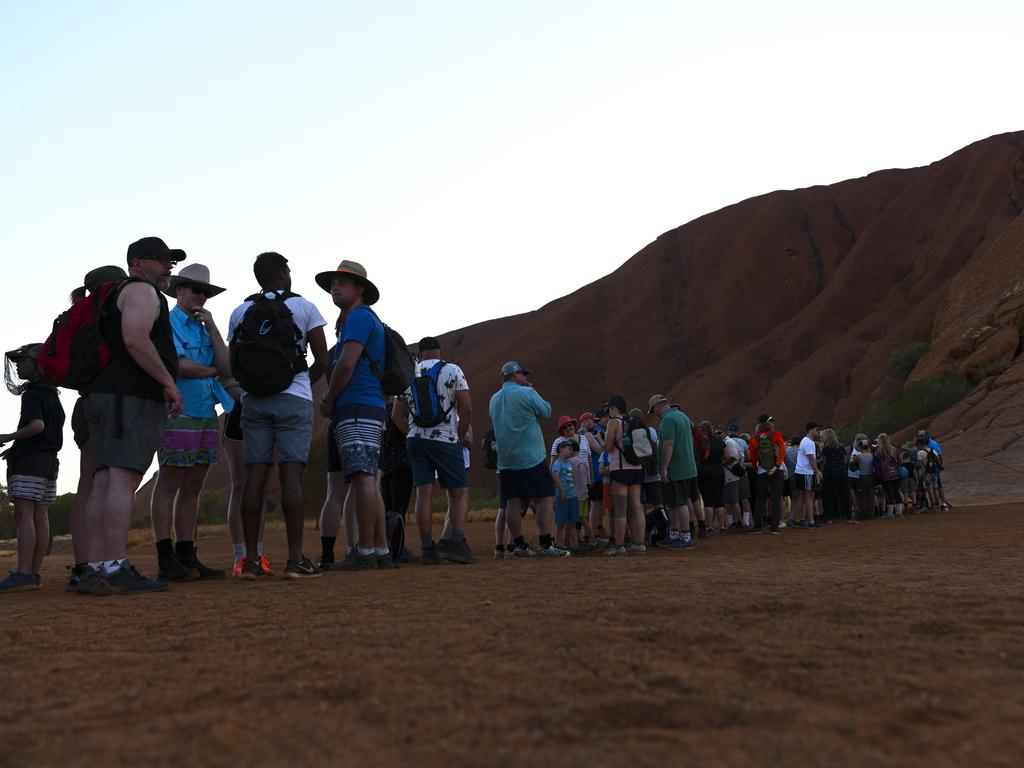Uluru’s owners face future without climb
As visitors flock to climb Uluru ahead of a ban that comes into place this weekend, there is a hidden reality that many of them miss completely.
As tourists flock to climb Uluru ahead of a ban this weekend, the majority of some 400,000 visitors to the area will have little or no interaction with the Anangu Aboriginal people from Mutitjulu.
At the crowded Ayers Rock Resort, tourists from Australia and overseas might see indigenous women painting and selling their work and a few Anangu staff (less than 30) who are far outnumbered by backpacker or Aboriginal employees from interstate.
The resort in the 35-year-old town of Yulara provides some luxury in the middle of the harsh Australian outback but nearby Mutitjulu is a different story.
The indigenous community of roughly 350 people is located on the opposite side of Uluru to the steep, western face tourists climb. That will be closed from October 25 in recognition of the rock’s cultural significance to the Anangu traditional owners.
RELATED: Uluru fact everyone wants to know
Mutitjulu is impoverished and littered with dilapidated buildings, rubbish and abandoned cars.
That is a shocking paradox for many who expect Uluru’s owners to receive decent income, similar to mining royalties for indigenous people elsewhere.
The view outside the window of Anangu elder Dorothea Randall’s living room in Mutitjulu is dominated by the awesome sight of Uluru, which is so close you can feel the heat radiate off it sometimes, she tells AAP.


“I embrace that every morning as a blessing,” she says.
There has long been tension among traditional owners around the money climbers bring in versus Uluru’s importance as a sacred site to them.
The cultural importance relates to Tjukurpa, the Anangu word for their Dreamtime and the foundation of their culture including rules for living. Tourists pay $25 to go to Uluru, of which the Central Land Council representing numerous indigenous groups receives 25 per cent.
The council gives some to Mutitjulu — only about one-fifth according to Ms Randall — and it gets no royalties from the resort.
There is some bemusement as to why the Anangu would ban the climb and risk the tourist money.

A shift in thinking toward a ban occurred among the Anangu who began to believe allowing climbing was damaging their culture, Ms Randall says.
Numerous incidents contributed, including a man’s suicide and his body being found six months later, at least 37 other climber deaths, a Frenchwoman’s striptease filmed on top, other nudity, golfing and human waste coming off the rock into waterholes driving away wildlife.
“Our mob believed that at the base of this rock is our Tjukurpa, that’s our law and if we believe in our Tjukurpa we should be strong in our culture,” she says.
The specific reasons why the rock is sacred are not clear to visitors apart from signage telling simple myths and stories that children can understand with universal religious themes about right and wrong.
That is partly due to Aboriginal protocols that restrict what is told to non-Anangu.
However, for indigenous owners, it was a key part of their identity, voice and beliefs, Uluru Kata Tjuta National Park culture and heritage project officer Shaeleigh Swan said.
“The creation stories and how the rock was created and how the Anangu people came to be is the Tjukurpa, everything carved into the landscape is there for you to see,” she told AAP.
Whatever economic and tourism uncertainties there are, Ms Swan says she believes that “giving the Anangu the opportunity to make decisions on their land” is an empowering one like Native Title that keeps their culture strong.
While most Mutitjulu residents support the ban, Kevin Cooley, who was out in a truck collecting rubbish for the Mutitjulu Corporation, admitted to some concerns about losing tourism.
“I am happy and sad, two ways, tourists come here and we like it and welcome them,” he told AAP.

However, his workmate Xavier Kitson said there were “a lot of sacred sites and sacred stories, dreaming and meaning” at the rock and it should not be climbed.
“If I tried to climb on top of that white house at Canberra, Parliament House, they wouldn’t let me in there,” he said.
“I want people to walk around it but not coming from overseas to climb and die on top of the hill, it is dangerous and you might as well put all the coffins on top of the rock.”
The general manager of the national park, Michael Misso, said it was not acceptable to have a community living in poverty around a tourist icon instead of benefiting.
“It is Aboriginal land and if the people who own the land aren’t benefiting from the tourism activity there, there’s a real issue of sustainability of tourism I believe anyway,” he told AAP.
“The key is getting more Anangu engagement in the tourism industry.”
He is hopeful a recent Commonwealth sublease for Mutitjulu which will make it easier to invest in, will bring more tourism businesses such as cultural tours.


Media reports of child abuse and social dysfunction in Mutitjulu sparked the Howard government’s controversial intervention in 2007 in which the army was used and harsh welfare restrictions imposed.
The intervention caused a lot of psychological damage to innocent men who were productive workers at the time and were wrongly tainted, Ms Randall says. The town was recovering but still had its social problems and its children lacked confidence and enough role models, she said.
Fixing its problems meant having people working in the tourism industry instead of being on the dole and children had to be educated in a way that respected their Anangu culture because western society was different, she said.
“Canberra tend to make a lot of policies down there that doesn’t suit a remote community at all,” Ms Randall said.
Aboriginal people have been in Australia for tens of thousands of years, so the brief time tourists have climbed on Uluru is tiny, Mutitjulu resident and Central Land Council chair Sammy Wilson said.
“It is just a blip in the middle, this whole climb thing, it is going back to normal by banning the climb.”



